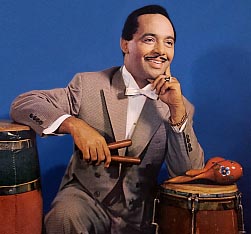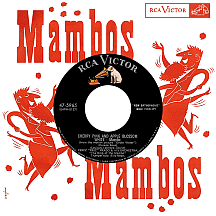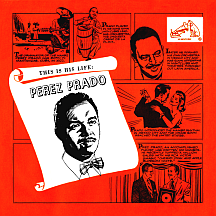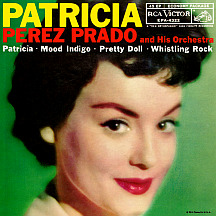PEREZ PRADO
The most popular Latin music has always been about dancing...the steps, the beat, la pasión. The Tango, a dance designed with couples in mind, came out of Argentina around the turn of the century with movements, perceived by some as suggestive, fueling its popularity. The Samba, a methodical extension of primitive, tribal African dances, developed in Brazil around the same time, reaching its peak during the 1940s and '50s. The Rumba, a musical style compatible with these and other dances, gained favor in Cuba during the '30s and '40s, popularized in the U.S. by Spanish-born, Havana-based bandleader Xavier Cugat. Cuban conga man Desi Arnaz made a name for himself in Miami in the late '30s, later performing with Cugat before starting his own band in New York and creating a popular Conga line dance. Each of these trends had its own rhythm, usually derived from a combination of the previous styles with some new step or variation in timing to make it stand apart. By the end of the '40s, there came a new sound and dance destined to prevail in the following decade: the Mambo! The man responsible for this latest, greatest and most energetic of Latin dance trends was Dámaso Pérez Prado.
Growing up in Matanzas, about 65 miles east of Havana on Cuba's north shore, Prado studied classical piano but was soon seduced by the rhythm. He moved to Havana in the mid-1930s while still in his teens and spent several years getting established, ultimately forming his Orquesta Casino de la Playa (casino-at-the-beach band). Around 1947, he made at least one recording for the Cuban label Discos Cafamo, "Tu Ve, Tu Ve," actively promoting his new sound as mambo, but this style, even a subtle use of it, didn't go over well in Havana. Some people, including lawmakers in certain districts, compared it to a so-called Haitian "voodoo" dance. Prado left his home, traveled around South America, headed north and wound up in Mexico City, where audiences went muy loco for what he had to offer. He formed a new, diverse band of musicians: Afro-Cubans, Mexicans, Spanish Indians and even a few white guys!
In 1949, he signed a recording contract with RCA Victor Mexicana and began recording at the label's studio in Mexico City. He backed Puerto Rican singer Myrta Silva on "El Tumbaito (Guaracha Son)" and released his own single, with jazz overtones, titled "José." RCA Victor began releasing his output for the Latin market in the U.S.; a mambo-adjusted take on Ernesto Lecuona's '20s classic "Malagueña" followed, coupled with "Anabacoa," a typically fast-paced guaracha track featuring Cuban singer Beny Moré. But it was the next release that lit the fires. "(Qué Rico) El Mambo," a tune that packed the dance floors, was recorded and released in late 1949. It soon became known informally as "Mambo Jambo" and was so big that the follow-up, continuing the momentum, was titled "More Mambo Jambo." The "Qué Rico" flip, "Mambo No. 5," would become even more significant as time progressed.
Prado kept busy over the next year, releasing about a dozen records for RCA, most of them billed as Pérez Prado y su Orquesta including "Mambo No. 8" and other originals (songwriter credit: D. Pérez Prado) with the purpose of further promoting his sensational dance. Occasionally he would apply the mambo beat to an established hit, such as "The Syncopated Clock Mambo," introduced in its original form by Leroy Anderson. Nightclub shows were lively affairs; Prado jumped around onstage, kicking, dancing, urging his band (with shouts and grunts) to play louder and hotter while patrons on the dance floor went wild. He appeared in several Mexican films (starting with Perdida in '50) and gave himself a nickname, "The King of the Mambo." A growing popularity with Latin music fans north of the border necessitated clearing his visa for touring purposes. In May 1951, he made his first U.S. appearance in Chicago.
A series of shows in Southern California had Prado leading a band of local union musicians; the crew he used in Mexico hadn't been granted permission to join him. His choice of players was top-rate and the shows were on par with the Mexican club shows. In New York City, he was as hot as the Latin bandleaders who'd come before him, performing for standing-room-only crowds who managed to dance while tightly-packed; Latin stars like Tito Puente joined the mambo party and many new acts formed because of it. Johnny Otis had an R&B hit in '51 with an instrumental, "Mambo Boogie," complete with those shouts and grunts, labeled by the press as "ungh!" sounds.
With the mambo hitting its stride and so many competitors on the bandwagon, Prado created two new dances: the Suby, a faster, ramped-up mambo, and Pau-Pau, a slower, relaxed equivalent. By 1952, his earnings were estimated at five thousand dollars per week, an amazing figure when compared to the few hundred pesos he'd been pulling in during his long-gone Havana days. The press frequently came around for interviews, though his English was far from fluent; he typically spoke to reporters using an interpreter. In early 1953, Prado recorded "Cerezo Rosa," its melody written three years earlier by French-Italian composer Louiguy, real name Louis Guglielmi (whose main claim-to-fame was his inspired creation of Édith Piaf's famous hit "La Vie En Rose"). The "pink cherry tree" song no fue un éxito at the time.
As radio stations in larger markets were diversifying their playlists, RCA Victor promoted him as a pop act, issuing singles on its main 47-prefix series. "Mambo No. 5" remained a steady seller a few years after its initial release as he began being booked in, and selling out, shows in cities where the residents were predominantly white. As his fame increased, Prado faced opposition from critics; heads of the Catholic church accused him of encouraging "sinful" dancing and the vocal cues evident on nearly all recordings to motivate his musicians were misinterpreted as sexual innuendo to arouse dancers. As with many forms of music presentation, there was some element of truth to the claims.
The mambo madness was interrupted in October 1953 when the Mexican govenment sent Pérez back to Cuba, claiming his visa had expired. But it didn't slow him down. He toured constantly in the U.S. due to increased demand, the dynamic presentation unchanged as he raised audience members' fevers on both coasts and many places in between. His influence hit its apex as the mambo took over popular music in '54. Several artists came on board with major hits: "They Were Doin' the Mambo" by Vaughn Monroe, "Papa Loves Mambo" by Perry Como and "Mambo Italiano" by Rosemary Clooney, plus Ruth Brown's number one R&B hit "Mambo Baby" and, in early '55, "Mambo Rock" by Bill Haley and his Comets (whose next release would bear some significance to Prado and, moreso, to the entire music world). Then there was the inevitable send-up: R&B funsters The Treniers released "Who Put The 'Ungh' In The Mambo," suggesting the whoops and grunts had replaced 'Arriba! Olé!'
RCA's crossover positioning of the "King" neared completion as records began crediting him as Perez "Prez" Prado, dropping the accent on the first "e," effectively changing the pronunciation. Almost immediately he conquered the charts with one of the all-time biggest instrumental hits. Non-hit "Cerezo Rosa" had previously been translated - loosely - as "Cherry Pink and Apple Blossom White," which was the main title on the label of a version re-recorded for the Howard Hughes film Underwater starring Jane Russell. Prado's new recording featured trumpeter Billy Regis, whose sliding-note technique proved irresistible to listeners. The song entered the charts two months after its January release, gradually gaining in sales as radio play and juke box spins followed. At the end of April it reached number one and everything else fell into place over a ten week stay at the top; throughout the month of June the song dominated all three of Billboard's mainstream charts, a rare feat for a Latin record. Finally, in early July, the song gave way to a new number one: Haley's "Rock Around the Clock," the first rock and roll single to top the charts. This particular changing-of-the-guard came to represent the difficulty Prado, and many other artists, would experience in attempts at reaching previous highs as America's youth began buying records like never before...and teen-oriented rock and roll was their preference.

Nevertheless, "Cherry Pink and Apple Blossom White" emerged victorious, the biggest hit of 1955, the hottest selling single with the most impressive run on the charts; Haley's rock milestone came in second for the year. In England, Prado's recording also reached number one, just ahead of a near-identical cover by trumpeter Eddie Calvert that also hit the top of the U.K. charts. The song's success throughout many parts of Europe exposed a scam that had been going on there for some time...perpetrated by a family member, no less! Pantaleóne Perez Prado was shrewdly cashing in on his older brother's name, performing in several European countries while billing himself as "The King of the Mambo." When Perez found out, he took time off to go to Paris, get a "cease and desist" order and file a half-million-dollar lawsuit against his spurious sibling. Once back in the States, the real Perez Prado continued to milk the mambo craze and success of "Cherry Pink," doing so without benefit of a follow-up hit. Three years passed, by which time the mambo had run its course. In 1958, a midtempo original with a more mainstream sound was issued, though expectations were low. "Patricia," featuring Prado on organ, was a surprise hit, becoming his second number one smash in July.
This time, though, the Mambo King scored with a follow-up. "Guaglione," by Tuscan composer Giuseppe Fanciulli, was given a newer (not-so-mambo) treatment and peaked in Cash Box magazine's top 20 in October '58. A vocal version of the melody, titled "Bambino" (Italian lyrics by Nicola Salerno, a.k.a. Nisa), had previously been recorded by Egypt-born Italian singer Dalida (in French, with lyrics provided by Jacques Larue); in 1957 it spent seven months at the top of the charts in France, an all-time record. The flip side of "Guaglione," coincidentally, was a Prado original titled "Paris," which made a minor chart appearance, as did his early 1959 single "The Millionaire."
While he kept cranking out singles and albums for RCA, it became clear the glory days were over. In 1961 he introduced a new dance, La Chunga, with the track "Ritmo de Chunga," but it wasn't Prado's brainchild; this stepper was created by Arthur Murray and wife Kathryn, his rug-cutting partner of 35 years. Perez appeared on the charts one final time in the spring of 1962, tying into the current craze with an update to one of his two blockbuster hits: "Patricia-Twist." After parting ways with RCA in 1964, he had a brief association with United Artists Records and thereafter recorded for a number of international labels. Performing regularly in North America, he made his final U.S. appearance in 1987 at the Hollywood Palladium. He passed away in 1989 at the age of 72, at his home in Colonia del Valle in the heart of Mexico City.
But the hits didn't stop coming. Five years later, a Guinness Stout commercial featuring "Guaglione" caused a sensation in the U.K.; the single was re-released there, and in 1995 it rose to number two on the charts. A "Space Age Pop" (or "Bachelor Pad") trend was big in the States at the time, restoring life to a variety of '50s and '60s instrumentals (particulary gimmicky stereo recordings with unusual instrumentation or sound effects). The King of the Mambo's cool late-'50s hit had secured a place in the space-pad-lounge-whatever pantheon. Then in 1999, singer Lou Bega's remake of "Mambo No. 5" became un gigante international hit. Ten years after his death, Pérez Prado remained a musical force. He probably won't reliquish his title anytime soon, if ever.
NOTABLE SINGLES:
- Tu Ve, Tu Ve - 1947
- El Tumbaito (Guaracha Son) - 1949
by Myrta Silva with Pérez Prado - José - 1949
- Malagueña /
Anabacoa - 1949
by Beny Moré with Pérez Prado y su Orquesta - (Qué Rico) El Mambo /
Mambo No. 5 - 1949 - More Mambo Jambo - 1950
- Pianolo - 1950
- Mambo No. 8 - 1950
- The Syncopated Clock Mambo - 1951
- La Chula Linda - 1951
- Silbando Mambo - 1951
- In a Little Spanish Town (T'was on a Night Like This) - 1951
- Wild - 1951
by Johnny Hartman with Pérez Prado and his Orchestra - Perdido - 1952
- Cerezo Rosa (Cherry Pink and Apple Blossom White) - 1953
as Pérez Prado y su Orquesta - Mambo De La Telefonista (Mambo Of The Telephone Operator) - 1953
- Rosita - 1953
- Skokiaan - 1954
as Perez "Prez" Prado - Marilyn Monroe Mambo - 1954
as Perez "Prez" Prado - Cherry Pink and Apple Blossom White (Cerezo Rosa) - 1955
as Perez "Prez" Prado, trumpet solo: Billy Regis - Fredy - 1955
by Eartha Kitt and Perez Prado - Crazy... Crazy... - 1955
- Pretty Doll - Mambo Culeta (Que Linda Nena) - 1955
- Patricia /
Why Wait - 1958 - Guaglione /
Paris - 1958 - The Millionaire - 1959
- Patricia-Twist - 1962
- Girl with Green Eyes - 1964




